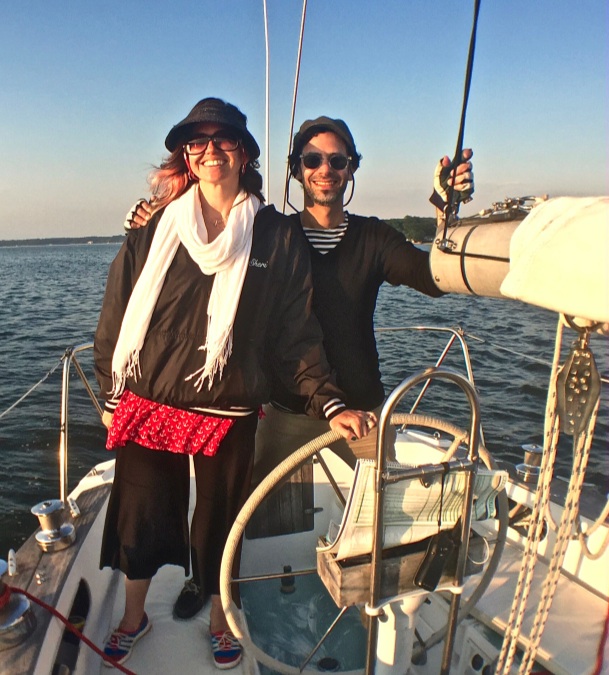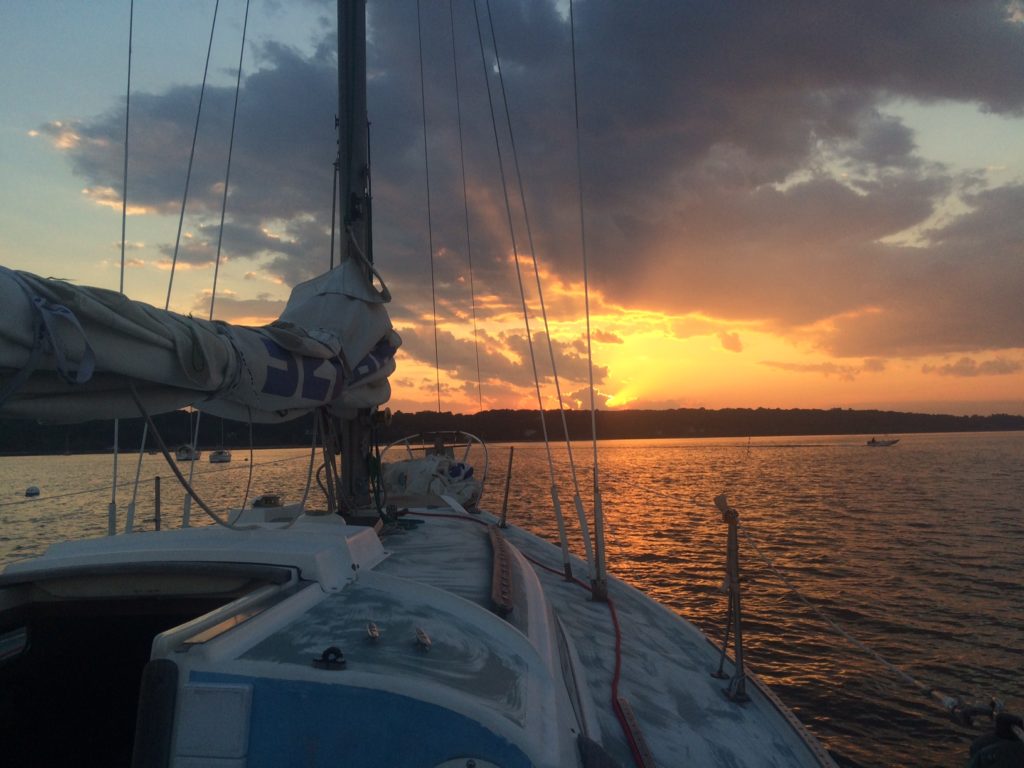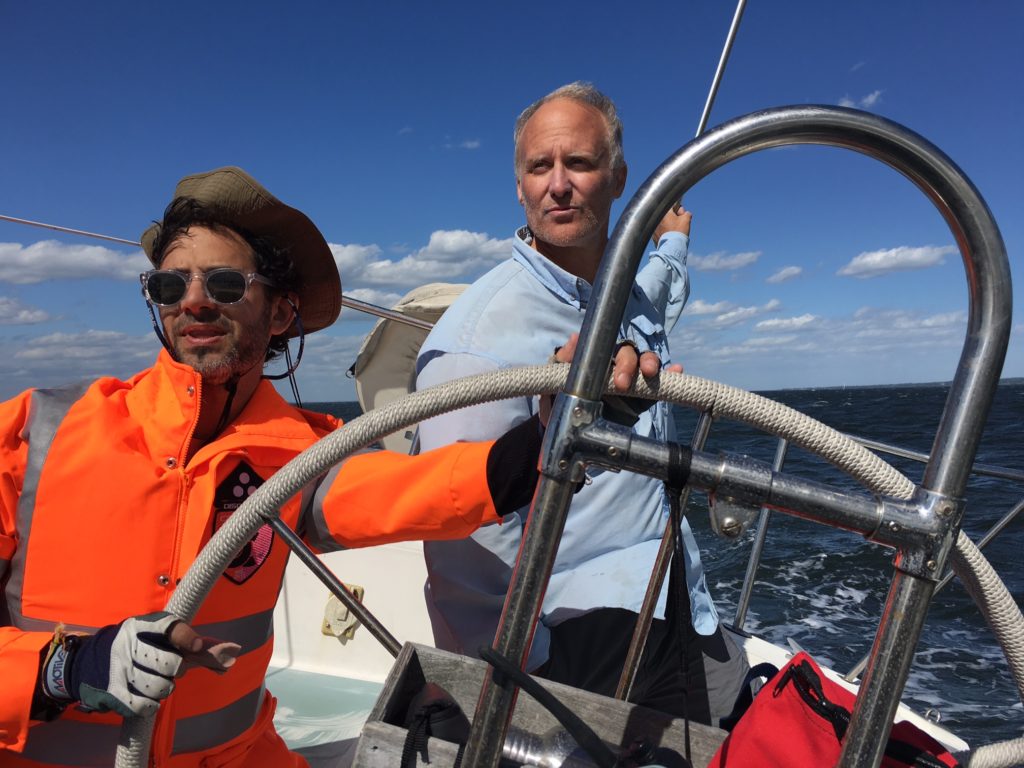We previously reported on the tragic death of two sailors in the current, ongoing Clipper Race. This long, multi-stage race around the world is unique. It’s one-design racing with a fleet of a dozen 70-foot sailing yachts. They look a little like scaled up versions of our 21-foot Beneteau sloops, but most of what they have in common with our little guys is twin rudders.
Most serious distance ocean racing events use boats with twin rudders, including the Mini-Transat, with 6.5 meter boats singlehanded across the Atlantic! However, almost all other boats use a single rudder. Twin rudders are best for these long races, and also best for learning. (For more on how that works, and why ASA decided that the twin-rudder design we’ve been using since 1998 was their idea of the ultimate learning machine, see more on our web site.)
The fleet has departed Seattle, having completed a grueling leg from China, and is en route to New York by way of the Panama Canal.
A student from our school, Fabio Peixoto, sailed in a prior Clipper race. We asked if he’d share his experience and perspective, and here’s what he had to say…
“The Clipper race is considered the longest sailing race around the world. It is not only that, but it is also the only sailing race around the world open to amateurs! Everyone in the boat is a paying passenger, except the skipper. This feature makes it a very unique race and it gives the opportunity to amateur sailors like me to have an experience as close as possible to the Volvo ocean race.
The Clipper race stops in many ports, including New York City. When I learned about it I decided to check. This was back in 2010. I contacted them through their website and had a face-to-face interview with the sailing director when the boats arrived. The interview went well; I think they just want to make sure the candidate is not insane, and I decided to go ahead and book my first few training sessions.
Everyone can sign up for the race, from complete novice to Olympian sailors and everyone has to go through the same training process; a 4 level training session, around 32 days total. You can split the sessions anyway you want. I did the first 2 levels in 2 weeks in November 2010. The third session was in April 2011 and the 4th session in June. The race started on July 31st, 2011.
The training happens in the Solent, south of England. It is very professional, intense training. The instructors are old race skippers or new ones in training. We go out in any condition – no wind or gale force wind. We should because during the race we will have to face whatever Mother Nature throws at us. A lot of novices who sign up with romantic views of sailing give up after the first level. Sailing is wonderful, but it has its rough patches. But most people who are sailors know what to expect and have a great time! It is awesome to train in those big, racing boats under any condition. You feel like a professional!
I signed up for the first half of the race. It would be a little over 4 months of racing, from July 31st to December 13th 2011. We started in Portsmouth, England and had our first stop in Madeira Island. Then we stopped in Rio de Janeiro, Cape Town, Geraldton, Australia, Tuaranga, New Zealand and Gold Coast, Australia, where it was my last stop. The race continued to China, crossed the Pacific to San Francisco, crossed the Panama canal, and sailed to New York, before crossing the Atlantic again and finishing in England. The complete race takes one year. Half the boat is booked for circumnavigators and half to leggers.
I can tell you that the race was an amazing experience! I have nothing but praise to the Clipper race! It is a very well run race, and they are very professional. I have sailed through squalls, gales and storm force winds. I have also seen amazing marine life, two lunar rainbows and, I believe, a green flash. I highly recommend the race to sailors who want to gain offshore experience. Offshore sailing is one of the last true adventures in the world!
The current Clipper race is their 20th edition. There have been many injuries before, including during my race. It is inevitable given the conditions that we sail; broken ribs, broken legs, concussion, etc. However they have never had a fatality in all those years. Unfortunately it seems they ran out of luck; there has been already two deaths in this race. Coincidence or not, in the same boat, Ichor Coal.
The first casualty happened right on the beginning of the race, on their way to Rio. It is still not clear the reason, but it seems that right after a reefing procedure, Andrew Ashman was hit by the main sheet or the boom and fell unconscious. They tried to resuscitate him in vain. The boat was diverted to Porto in Portugal to drop off the body.
This was the first death in 20 years and the conditions seemed to indicate an unfortunate causality. However, on April 1st 2016 another sailor on the same boat, Sarah Young, fell overboard in the Pacific during rough conditions. She was not tethered when a big wave washed her overboard. After one hour of searching, she was found. Unfortunately she had already died of hypothermia and/or drowning. Due to the distance to land, a decision was made to have a sea burial.
The first death seemed to be an unfortunate case but the second one shocked me. Specially because I went almost overboard in very rough seas in the Southern ocean. It was 2 AM and we were going through a gale with gust to 60 knots. I had just finished driving for one hour when the skipper took over. I was sitting next to him and then I decided to go down in the cabin to have some water. As soon as I unclipped to go under the traveler, a huge wave hit the boat. I felt this very strong water pushing on my back. My left hand was holding the binnacle and I wasn’t letting it go for nothing! The only thing I was thinking was “F****, I am not clipped in!” Fortunately I was able to hold myself and the only damage was a little bleeding on my nose from hitting the skipper’s leg and a bit of a twist to the binnacle frame. If I went overboard at 2 AM under those conditions, it would be very hard to find me. And even if they’ve found me, bringing me back into the boat with that sea state would be extremely difficult!
Even after these two tragedies, I still have trust in the Clipper race. Their training program is excellent and there is a big focus on safety! We are reminded of clipping-in all the time, not only during training, but also during the race. Andrew’s death seems to have been bad luck, but Sarah’s could have been prevented if she was tethered to the boat. I do not know if it was her fault of if she was in the process of changing jack lines, like in my situation in the Southern ocean. I just know that accidents happen, especially in extreme sports like offshore racing. I hope that the rest of the race goes smoothly and I wish the best to all racers! There is no adventure without risks.
Fabio Peixoto


